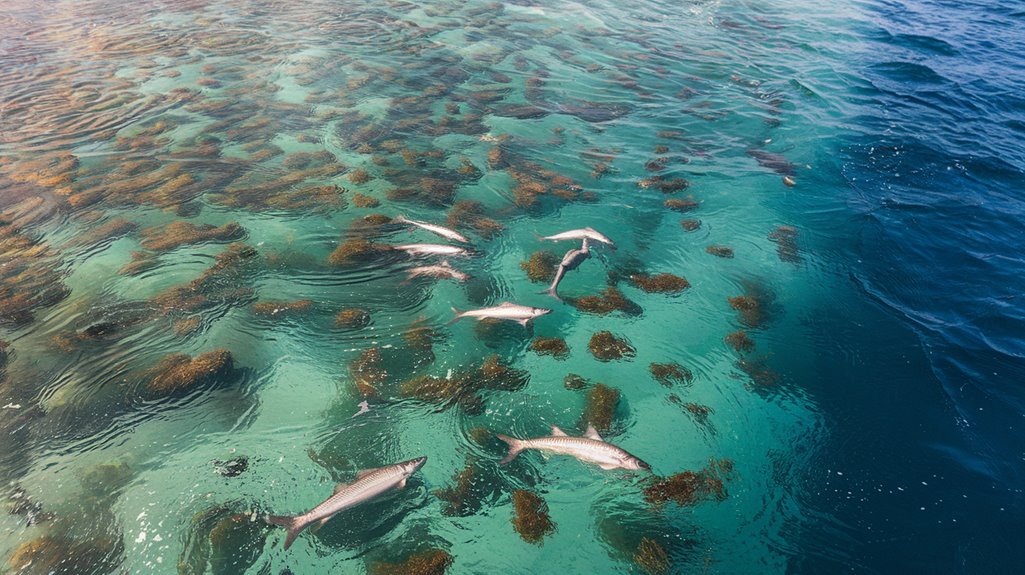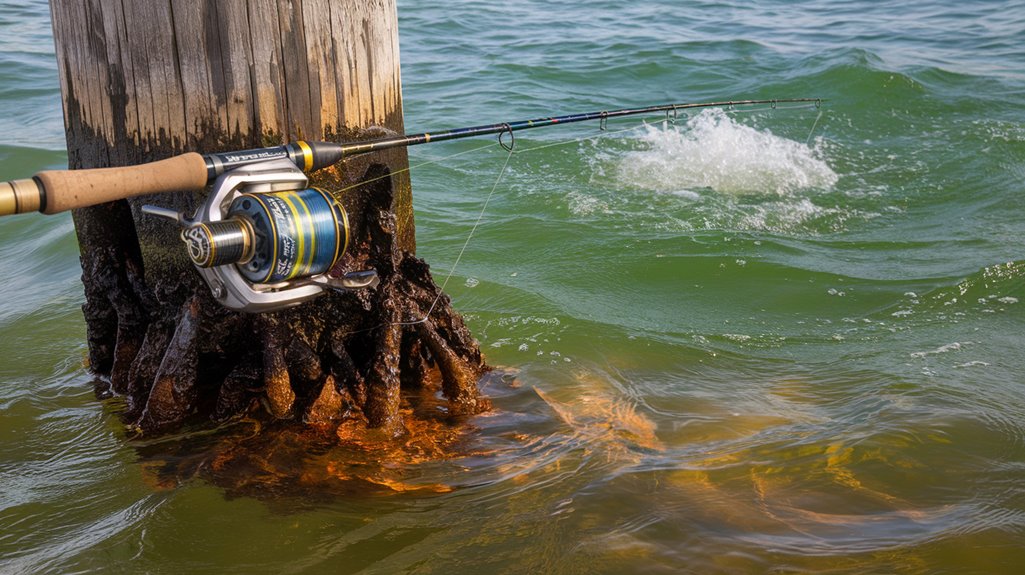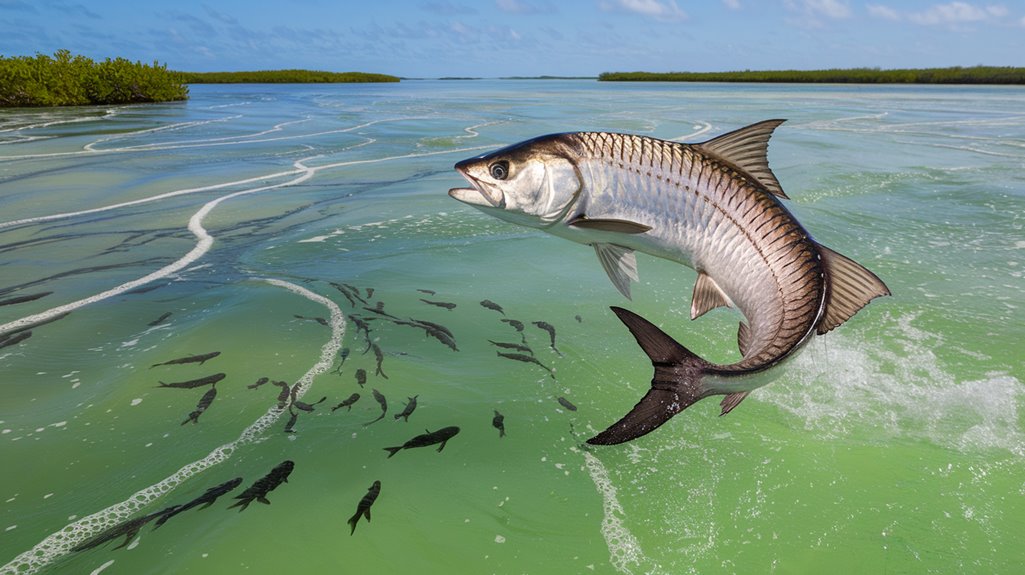You'll find that mastering current dynamics is vital for consistent tarpon success. These magnificent fish position themselves in tidal flows of 2-4 knots, where water movement concentrates their prey species, particularly during dawn and dusk periods. When you're analyzing potential fishing locations, it's important to reflect on how incoming and outgoing tides create distinct feeding zones at specific depths, temperatures, and convergence points. The relationship between current velocity and tarpon behavior offers intriguing tactical possibilities.
- Key Takeaways
- Understanding Tidal Movements and Tarpon Behavior
- Key Current Patterns That Attract Tarpon
- Best Tide Phases for Landing Trophy Tarpon
- Reading Water Flow for Prime Fishing Spots
- Current-Based Strategies During Different Seasons
- Equipment Selection for Strong Current Conditions
- Bait Presentation Techniques in Moving Water
- Weather's Impact on Current Strength
- Navigating Pass Fishing During Peak Flows
- Moon Phases and Current Relationships
- Safety Considerations When Fishing Strong Currents
- Frequently Asked Questions
- Conclusion
Key Takeaways
- Currents concentrate baitfish into confined areas, creating prime tarpon feeding zones near creek mouths, sandbars, and structural elements.
- Strong currents of 2-3 knots form distinct ambush points where tarpon actively hunt, particularly during tide changes.
- Tidal movements directly influence tarpon activity, with peak feeding occurring 1-2 hours around tide changes during full moon phases.
- Current velocity determines bait presentation techniques, requiring different weight selections from light to heavy based on flow strength.
- Incoming tides push tarpon into shallow ecosystems, while outgoing tides concentrate them in deeper channels with 2-4 knot currents.
Understanding Tidal Movements and Tarpon Behavior
When targeting tarpon effectively, understanding the relationship between tidal movements and predatory behavior is essential for the best results. You'll observe peak tarpon activity during incoming tides, as currents draw baitfish into shallower ecosystems, particularly around creek mouths and sandbars. During outgoing tides, tarpon exhibit strategic feeding patterns in deeper channels, utilizing strong currents for prey ambush.
Tidal movements greatly influence tarpon behavior, with slack tides resulting in decreased metabolic activity and reduced feeding patterns. You'll notice amplified predatory responses during full moon phases, when heightened tidal fluctuations create ideal hunting conditions. To maximize your success rate, analyze tidal charts to identify periods of strong water movement, as these correlate directly with increased tarpon activity and feeding opportunities.
Key Current Patterns That Attract Tarpon
You'll find tarpon congregating in areas where tidal flows create distinct feeding zones, particularly where currents of 2-3 knots channel baitfish into confined spaces. When plotting your fishing locations, target moving water patterns that concentrate prey species along current edges, especially during peak lunar phases when tidal fluctuations are strongest. The most productive fishing spots typically occur at current breaks where fast-moving water meets slower zones, creating natural ambush points where tarpon can efficiently intercept their prey.
Tidal Flow Feeding Zones
Understanding tidal flow patterns is critical for locating prime tarpon feeding zones, as these predatory fish strategically position themselves to maximize their feeding efficiency during specific tidal stages. You'll find distinct feeding behaviors correlated with tidal movements:
- During incoming tides, tarpon activity intensifies at creek mouths and sandbars, where they pursue baitfish in depths of 3-8 feet
- Outgoing tides concentrate feeding in deeper channels and passes, with ideal current velocities of 2-4 knots
- Peak feeding occurs during tidal shifts, particularly within 1-2 hours of tide changes during full and new moon phases
You'll want to avoid slack tide periods, when reduced water movement decreases tarpon activity by up to 70%. Instead, focus your efforts on strong tidal flows where currents create ideal ambush conditions.
Moving Water Bait Patterns
Strong current patterns create prime hunting grounds for tarpon, directly influencing their feeding behavior and bait presentation strategies. You'll find that moving water concentrates baitfish in predictable locations, particularly during tidal changes when menhaden and mullet become vulnerable to predation.
During incoming tides, you should target creek mouths and points where tarpon feed aggressively on bait pushed inshore by current flow. Conversely, outgoing tides concentrate bait patterns in deeper channels and passes, creating ideal ambush zones. You'll notice that slack tide periods result in diminished feeding activity, as reduced water movement fails to trigger the tarpon's predatory response. To maximize your success, align your fishing schedule with peak current flows, when bait patterns are most pronounced and tarpon actively pursue their prey.
Current Break Hotspots
While tarpon seek out various feeding locations, current breaks emerge as their most predictable gathering points due to the convergence of moving and static water masses. You'll find these apex predators strategically positioned where water dynamics create ideal feeding conditions. During tarpon fishing expeditions, focus on these prime current break locations:
- Creek mouth confluences, where incoming tides concentrate baitfish schools and create dynamic feeding zones
- Deep-water passes experiencing strong outgoing tidal flows, providing natural ambush points for targeting prey
- Wind-affected surface areas where moderate air currents intersect with water movement, creating productive surface disturbances
When targeting these current breaks, you'll need to synchronize your approach with tidal phases, as slack water periods typically yield reduced activity compared to strong incoming or outgoing flows.
Best Tide Phases for Landing Trophy Tarpon
You'll find prime tarpon activity during outgoing tides in deeper channels and passes, where these powerful fish establish strategic ambush positions to intercept prey in high-velocity current zones. During incoming tides, focus your efforts on creek mouths and sandbars where increased baitfish activity draws trophy tarpon into shallow-water feeding zones. These distinct tidal phases create ideal conditions for different fishing techniques, with outgoing tides favoring deep-water presentations and incoming tides suited for sight-casting in skinny water.
Outgoing Tide Ambush Points
Tarpon consistently demonstrate predictable feeding patterns during outgoing tides, particularly in deep-water channels and passes where current velocity creates ideal ambush conditions. You'll find these apex predators strategically positioned in deeper channels, especially around structures like the Skyway Bridge, where they maximize their feeding activity.
To optimize your tarpon fishing success during outgoing tides:
- Position your vessel in areas where water displacement creates distinct eddies
- Target the final hour of outgoing tide when feeding intensity peaks
- Focus on structural elements that concentrate baitfish movement
The hydrodynamics of outgoing tides create prime hunting zones where you can intercept trophy-sized tarpon. By identifying these strategic ambush points and timing your approach with tidal movements, you'll greatly increase your chances of encountering these magnificent gamefish.
Incoming Tide Feeding Zones
As the tidal cycle shifts, incoming water masses create distinct feeding opportunities that differ greatly from outgoing tide patterns. You'll observe tarpon exhibiting heightened activity levels when incoming tides push baitfish concentrations into shallower waters, particularly around creek mouths, points, and sandbar formations.
The initial hours of incoming tides present ideal conditions for targeting trophy specimens, as these feeding zones experience concentrated predatory activity. You'll maximize your success by analyzing current convergence points, where multiple water flows intersect to form natural baitfish aggregation areas. Position yourself strategically at these feeding zones, utilizing lures that accurately replicate indigenous baitfish species. The tarpon's aggressive feeding behavior during these incoming tide periods considerably increases your probability of successful hook-ups, especially when you focus on areas where current patterns create natural ambush points.
Reading Water Flow for Prime Fishing Spots

Understanding water flow dynamics is essential for identifying prime tarpon fishing locations during varying tidal conditions. You'll observe distinct hydraulic patterns that create ideal feeding zones where currents intersect with structural elements. These interactions form concentrated areas where tarpon ambush their prey.
When analyzing potential fishing spots, focus on:
- Velocity differentials between primary and secondary currents, particularly in deeper channels
- Formation of eddies and surface ripples near structural points, indicating baitfish aggregation
- Water clarity gradients where opposing flows meet, creating prime hunting zones
You'll maximize your success by positioning yourself upstream of these convergence points during peak current periods, whether on incoming or outgoing tides. Avoid slack tide periods when water movement diminishes, as tarpon typically reduce their feeding activity during these intervals.
Current-Based Strategies During Different Seasons
Seasonal variations in tidal dynamics greatly influence tarpon fishing success rates throughout the year. During spring and summer, you'll find ideal conditions during incoming tides when strong currents concentrate baitfish in shallower zones. In contrast, fall fishing demands a focus on outgoing tides in deeper channels where tarpon establish strategic ambush positions.
You'll need to adjust your approach during new moon phases when tidal movements diminish. Monitor peak tide swings carefully, as slack periods considerably reduce tarpon activity. Weather patterns, particularly barometric pressure drops, can trigger enhanced feeding behavior regardless of season. To maximize your success, integrate these environmental factors with current conditions. By synchronizing your fishing efforts with strong tidal flows and seasonal patterns, you'll increase your probability of productive tarpon encounters.
Equipment Selection for Strong Current Conditions

Strong currents demand specialized equipment to effectively target and land tarpon in challenging water conditions. You'll need a robust setup like the Daiwa 8000 BG reel paired with an 8-foot St Croix MOJO rod when fishing these powerful waters.
For targeting migrating tarpon in strong currents, equip your setup with:
- 65-pound braided mainline for ideal strength and sensitivity
- 60-pound fluorocarbon leader to maintain low visibility
- Heavy-duty terminal tackle with various weight options
Your equipment selection must account for the intense pressure of fast-moving water. When fishing these conditions, you'll want at least 40-pound test line minimum, though 65-pound braid offers superior performance. Keep multiple hook sizes and weights readily available to adapt your presentation based on current velocity and tarpon feeding patterns.
Bait Presentation Techniques in Moving Water
When targeting tarpon in moving water, effective bait presentation requires precise calculations of current velocity and drift rates to achieve ideal positioning. Your bait presentation techniques must account for water dynamics through strategic upstream positioning and weight adjustments to maintain optimal depth control.
| Current Velocity | Recommended Technique |
|---|---|
| 0-2 knots | Light weight, natural drift |
| 2-4 knots | Medium sinker, 45° cast angle |
| 4-6 knots | Heavy weight, upstream position |
| 6+ knots | Deep channel targeting only |
You'll need to modify your retrieval speed based on current strength, ensuring your lure maintains a wounded-baitfish action that triggers predatory responses. In stronger currents, position yourself upstream and calculate a 15-20% angle compensation for drift. Vary your presentation depth systematically, testing 5-foot increments until you locate the prime feeding zone where tarpon are actively hunting.
Weather's Impact on Current Strength
Through complex atmospheric interactions, weather patterns directly modulate current velocities in tarpon fishing zones, with barometric fluctuations serving as a primary driver of water movement intensity. You'll notice distinct correlations between weather conditions and current strength, particularly during pressure changes.
Key barometric influences on currents include:
- Low-pressure systems intensify water movement and trigger aggressive tarpon feeding patterns
- East wind patterns stabilize inshore currents, enhancing fishing conditions
- Storm-induced pressure drops accelerate water flow and alter salinity gradients
Understanding these weather-current dynamics helps you adapt your fishing strategy. Monitor approaching weather systems, as they'll affect current velocities and tarpon behavior. Light to moderate winds create ideal surface disturbances, while heavy precipitation can push tarpon deeper as currents intensify from increased runoff.
Navigating Pass Fishing During Peak Flows
When positioning your boat during peak flows, you'll need to anchor at a 45-degree angle to the current line while maintaining a safe distance of 75-100 feet from the primary edge of the pass. You must analyze the water's directional patterns to identify the confluence points where slack water meets the main current, creating ideal tarpon holding zones. To maximize your success rate, calculate your fishing windows to coincide with maximum current velocity periods, typically occurring 2-3 hours after the tide change during new and full moon phases.
Positioning Your Boat Effectively
As peak tidal flows surge through coastal passes, precise boat positioning becomes critical for successful tarpon fishing. You'll need to adapt your positioning strategy based on tidal phases to maximize your effectiveness in intercepting these apex predators.
During outgoing tides, strategically anchor in deeper channels where currents concentrate feeding activity. For incoming tides, position yourself near structure that creates current breaks and baitfish aggregations.
- Maintain a 45-degree angle to the primary current flow
- Adjust position every 15-20 minutes to compensate for tidal velocity changes
- Monitor current speed using surface indicators or flow meters
Reading Water Flow Patterns
Understanding peak flow patterns in coastal passes requires mastery of both visual and technological analysis methods. You'll need to evaluate current velocity, eddy formations, and baitfish movements to predict tarpon feeding zones. By utilizing sonar technology, you can identify subsurface structure affecting water flow dynamics.
| Current Type | Tarpon Behavior | Ideal Fishing Strategy |
|---|---|---|
| Outgoing Tide | Ambush Feeding | Position Uptide of Pass |
| Eddy Current | Holding Pattern | Target Edge Zones |
| Rip Current | Active Hunting | Drift Through Seams |
| Wind-Driven | Surface Feeding | Match Bait Presentation |
| Slack Water | Reduced Activity | Monitor Depth Changes |
During peak flows, observe how water movement creates distinct patterns around structural elements. You'll find tarpon congregating where these currents concentrate prey species, particularly during tidal exchanges when flow rates are highest.
Timing Peak Current Windows
Successful tarpon fishing in coastal passes hinges on precise timing of peak current windows during tidal cycles. You'll find ideal conditions during strong incoming and outgoing tides, when water movement creates prime feeding opportunities. Full moons amplify these tidal currents, particularly beneficial for night fishing operations in deeper channels.
To maximize your fishing efficiency during peak flows:
- Target the 2-3 hour window before slack tide when currents are gaining momentum
- Position your vessel in deeper passes where water velocity concentrates baitfish movement
- Anticipate feeding patterns during lunar-influenced current surges, especially around structures like bridge pilings
Understanding these hydrodynamic patterns helps you enhance your timing for when tarpon are most actively feeding, rather than expending energy during less productive slack tide periods.
Moon Phases and Current Relationships
The lunar cycle's influence on tidal movements creates distinct opportunities for tarpon fishing through predictable current patterns. During full and new moons, you'll experience heightened tidal fluctuations that generate stronger currents, greatly affecting how tarpon migrate and feed within these waters.
Full moon periods offer excellent nighttime fishing conditions, as the increased illumination combines with peak current flows, enabling you to target tarpon as they actively pursue prey. Conversely, new moon phases produce ideal daytime fishing scenarios during maximum tidal exchanges. You'll find tarpon concentrating in deeper channels and passes during outgoing tides, where they utilize current breaks to ambush prey. It's critical to avoid slack tide periods, as the reduced water movement correlates directly with decreased feeding activity.
Safety Considerations When Fishing Strong Currents
Safety must remain your top priority when pursuing tarpon in high-velocity currents, where water speeds can exceed 6 knots during peak tidal exchanges. Wearing a Coast Guard-approved PFD isn't optional – it's essential for survival if you're unexpectedly pulled into swift-moving water.
Before launching your vessel, implement these critical safety protocols:
- Conduct a thorough current velocity assessment using tide charts and local monitoring stations
- Deploy a minimum 15-pound anchor with a 7:1 scope ratio for maximum holding power
- Establish clear communication protocols with shore contacts, including GPS coordinates and estimated return times
You'll need to constantly monitor surrounding hazards, particularly during spring tides when current speeds intensify. Stay vigilant of submerged obstacles and maintain a 360-degree awareness of your position relative to potential danger zones.
Frequently Asked Questions
How Do Currents Affect Fishing?
You'll find currents drive fish movement patterns, influencing prey distribution, oxygen levels, and water temperature. Strong currents concentrate baitfish, while slack periods reduce feeding activity considerably.
How to Catch Tarpon in Canals?
Position yourself near canal constrictions during tidal shifts. You'll need 40-pound test line, live baitfish like mullet positioned at 6-8 feet depth, targeting areas with 75%+ water clarity.
Why Do Tarpons Jump Out of Water?
You'll observe tarpons executing vertical leaps of 5-10 feet to dislodge parasites, escape predation, and disengage from fishing hooks through rapid muscular contractions and hydrodynamic force generation.
Why Is It Illegal to Catch Tarpon in Florida?
With a 95% decline in historical populations, you can't keep tarpon in Florida because they're legally protected as catch-and-release only, ensuring survival of this ecologically essential gamefish species.
Conclusion
You'll find that mastering current dynamics is analogous to accessing a complex mathematical equation in tarpon fishing. By analyzing tidal velocities of 2-4 knots and monitoring lunar-driven flow patterns, you're optimizing your probability matrix for success. Like a hydrologist studying fluid mechanics, you'll need to calculate convergence zones where nutrient-rich waters intersect. These variables, when properly quantified, transform your approach from random sampling to precision targeting.

